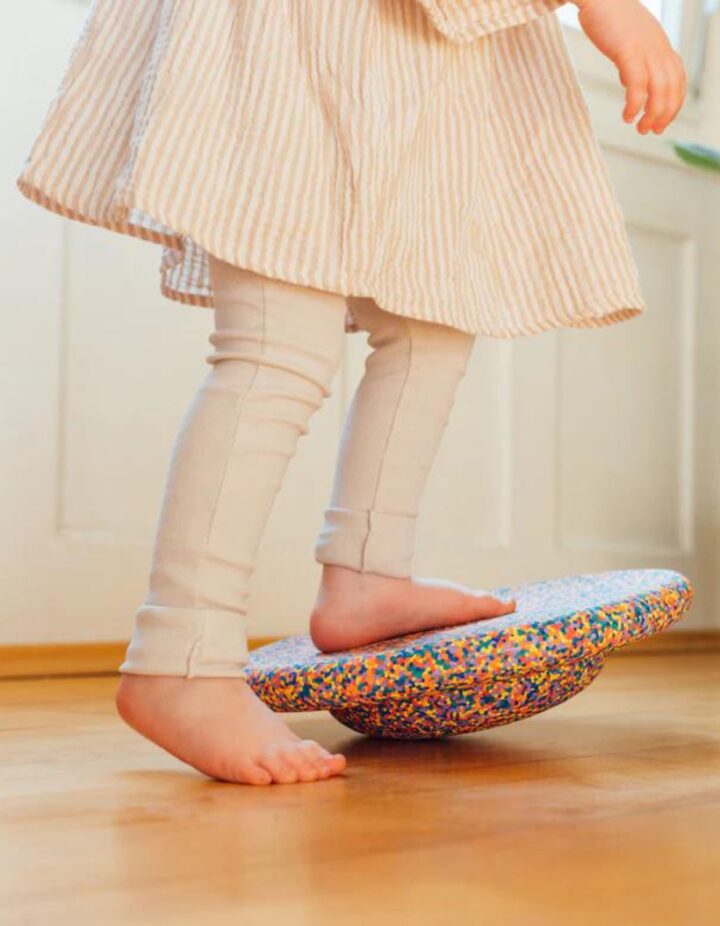In the tongue-in-cheek, spit-up-stained pages of parenting, there lies a stark reality: our babes are becoming expert-level loungers. But before you start envisioning your living room as a toddler’s corporate office, let’s introduce the game-changer: Stapelstein. This isn’t your average “get off the iPad” lecture; it’s a bona fide play revolution, a beacon of innovation storming the sedentary castle with color, form, and eco-conscious ingenuity.
Related: How to Start STEM Learning Early
Stephan Schenk and Hannah König, the visionaries behind Stapelstein, didn’t simply wake up one day and decide to create a play solution. They recognized a pressing issue: the lack of movement among modern children. ‘The problem we’re facing is a [lack] of movement at home,’ Schenk shares. ‘The World Health Organization is sounding the alarm, and yet, we’re struggling to meet even the most basic movement requirements.’

While we all appreciate moments of calm, it’s important to remember that stillness can hinder development. Our children are born to move—and Schenk understands this deeply. ‘Children need movement to develop a robust understanding of the world,’ he explains. ‘Play is the universal language of learning. And let’s face it, adults could use a refresher from that playbook.’
Imagine a product that’s a literal magnet for movement, a piece of design so clever it’s like a personal trainer for fun. “Our goal was to craft shapes that beg to be tumbled with—forms that are as dynamic as they are inviting,” Schenk explains. The beauty of contrast in Stapelstein’s world isn’t just about colors that pop; it’s about forms that roll and rest, wobble and stabilize.
And about that color theory—Stapelstein doesn’t do dull. They’re wielding a palette that’s a full-on color wheel rebellion. “This isn’t just about aesthetics; it’s about emotional and cognitive responses.” Speaking about colors…

Let’s talk green—no, not the color, the planet. In a world where ‘eco-conscious’ is tossed around like confetti, Stapelstein plants its flag in sustainability with conviction. Schenk’s approach is holistic, and it’s not just for show. “Designing for children means we have a non-negotiable obligation to think sustainably,” he says, pointing out that every decision, from material to the play potential, has to pass the future-proof test.
And just when you think they’ve thought of everything, they pull out another trick from their sleeve. The ‘inside’ edition isn’t just new—it’s a revolution within a revolution. “We’re leaving space for the child’s creativity to unfold,” Schenk says, “like a seed that grows into a blooming flower.” The product isn’t just about what it is; it’s about what it can become in the hands of a child—or any playful soul, for that matter.
Related: 6 Mamas On the Meaning of Movement
Here’s the kicker: Stapelstein isn’t just about selling you a stackable slice of genius; they’re here to shake up the entire playtime paradigm. Schenk makes it clear: “We’re not in the business of dictating play. We’re in the business of inspiring it. Our role is to set the stage for creativity and then step back and watch the magic happen.”

And oh, the magic! We hung out with the team from Stapelstein, along with some mamas and their babes, and saw SO. MUCH. PLAY. From stacking to spinning, balancing to splashing, sorting to drumming, and so much more, we saw babies as young as seven months old and children as old as eight enjoying the elements.
If the play is the work of childhood, then Stapelstein is the office renovation our kids deserve. Stephan’s design mantra and process is not form follows function, but form is function. This isn’t just about toys; it’s about a manifesto for movement, a declaration of fun, and a sustainable blueprint for the future. It’s time to roll out the rainbow carpet and let play take center stage.
Use code BABE10 for a 10% discount on your Stapelstein.




